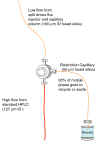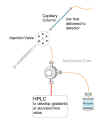Return to IonSource Homepage
The Truth About Splitting
|
||
|
Many commercial capillary HPLCs split their flow down from conventional flow rates in order to drive capillary HPLC columns. Splitting is a fact of life for much of capillary chromatography. A few commercial capillary HPLC systems have the ability to perform gradient HPLC in the low and now sub µL/min range. A non-splitting capillary HPLC is preferable for a number of reasons which will be discussed in the splitting issues section below. However, when choosing a commercial capillary HPLC system be sure to compare the two types of systems with a strict set of analytical criteria. Compare retention time stability, peak area statistics and linearity of a quan curve when choosing a system. It is thought that a lower split ratio is preferable. For example, splitting down to 100 nL/min. from 200 µL/min. is a split ratio of 1:2000 and splitting down from 3 µL/min. is only a split ratio of 1:30. It would be our advice that systems with a high split ratio should be compared functionally in a demo with those that have a low split ratio. "Prove it to me" should always be the attitude when choosing a new analytical instrument.
Splitting Issues |
 Figure 1 |
|
| (+) |
Flow splitting uses a simple inexpensive device, the tee, and it works. |
 Figure 2
|
| (-) |
If the column starts to foul the split ratio will change as more mobile phase is forced through the restriction capillary. Also if your chromatographic media swells or shrinks during the run, your split ratio will change. |
|
| Sol. |
When splitting, care must be taken to measure the flow rate periodically before starting a batch of analyses. If a column begins to foul the first clue is that retention times begin to lengthen. Capillary guard columns can be used to protect the analytical capillary column from fouling but this will not prevent a split ratio change in the case of fouling. |
|
| ------ | ||
| (-) |
When using a flow splitting tee the flow rate changes over the course of the organic gradient as the viscosity of the mobile phase changes. |
|
| (+) |
We have not been able to demonstrate this. See flow rate change experiment on the following page. As mentioned previously "if your chromatographic media swells or shrinks during the run, your split ratio will change." |
|
| ------ |

Figure 3
|
|
| (-) |
When using flow splitting most of the mobile phase goes to waste through the restriction capillary. HPLC grade solvent is expensive and it is even more expensive to dispose of as waste. The ideal situation is to have the capability not to split. Less waste means less environmental impact, less inspection solvent storage impact, and a healthier work environment. |
|
| (+) |
1) In isocratic mode the untouched waste exiting the tee
can be fed right back into the solvent reservoir for recycle, this is
not the case in gradient elution. |
|
|
. |
||
|
TOC Introduction Glossary Simple System Automation UV Detection Plumbing The Truth About Splitting Applications Order Components References |
 |
|
| - | ||
|
home
| disclaimer |
||